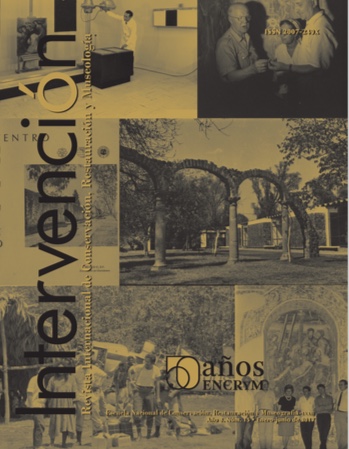Published 2025-01-16
Keywords
- pre-columbian instruments,
- sacrifice,
- self-sacrifice,
- organic remains,
- Mexico
- electron microscopy ...More
Copyright (c) 2017 Instituto Nacional de Antropología e Historia (INAH)

This work is licensed under a Creative Commons Attribution-NonCommercial 4.0 International License.
How to Cite
Abstract
This research focuses on seven ritual instruments, whose formal typology has been liked with sacrifice and self-sacrifice in different pre-Hispanic cultures of today Mexico. Its purpose was to find organic human remains that would link the artefacts with the abovementioned practices. The study began by obtaining samples from four elements made of obsidian, a maguey spike, and two tip points carved out of bone, all which were subjected to scanning electronic microscopy (SEM). Finally, an interdisciplinary team of restoration and medicine professionals interpreted the results, which concluded with the identification of diverse organic diagnostics remains, such as blood cells and human tissue remains.
Downloads
References
- Allen, Jane, Margaret Newman, Mary Riford y Gavin Archer (1995). “Blood and Plant Residues on Hawaiian Stone Tools from Two Archaeological Sites in Upland Kàane'ohe, Ko'olaw Poko District, O’ahu Island”, Asian Perspective, 34 (2):283-302.
- Anderson, Patricia (1980). “A Testimony of Prehistoric Tasks. Diagnostic Residues on Stone Tool Working Edges”, World Archaeology, 12 (2):181-194.
- Armitage, Mark y Kevin Lee Anderson (2013). “Soft Sheets of Fibrillar Bone from a Fossil of the Supraorbital Horn of the Dinosaur Triceratops horridus”, Acta Histochemica, 115 (6):603-608.
- Barnard, Hans y Jelmer W. Eerkens (eds.) (2007). Theory and Practice of Archaeological Residue Analysis, Londres, British Archaeological Reports.
- Bello, Abel (2004). Hematología básica, México, Prado.
- Boone, Elizabeth (ed.) (1984). Ritual Human Sacrifice in Mesoamerica, Washington, Dumbarthon Oaks.
- Brown, Terry y Keri Brown (2011). “Potential and Problems of Immunological Methods in Biomolecular”, en Terry Brown y Keri Brown, Biomolecular Archaeology: an Introduction, Oxford, Wiley-Blackwel, 50.
- Charlier, P., P. Georges, F. Bouchet, F. Hugnh-Charlier et al. (2008). “The microscopic (optical and SEM) examination of putrefaction fluid deposits (PFD), potential interest in forensic anthropology”, Virchows Arch, 453 (4):377-386.
- Dier, Amanda (2011). “Current Approaches to Protein Residue Analysis”, Popular Archaeology, 4, documento electrónico disponible en http://popular-archaeology.com/issue/september-2011/article/current-approaches-to-protein-residue-analysis, consultado en abril de 2016.
- Eisele, J. A., D. D. Fowler, G. Haynes y R. A. Lewis (1995). “Survival and Detection of Blood Residues on Stone Tools”, Antiquity, 69 (162):36-46.
- González, Yólotl (1985). El sacrificio humano entre los mexicas, México, FCE.
- Graulich, Michelle (2005). Les sacrifices humaines chez les aztèques, París, Fayard.
- Henderson, Lucía (2012). “Buscando las entrañas: un reconocimiento del sacrificio humano en el mundo maya a partir del periodo Preclásico”, en Bárbara Arroyo, Lorena Paiz Aragón y Héctor Mejía (coords.), XXV Simposio de Investigaciones Arqueológicas en Guatemala, Guatemala, Ministerio de Cultura y Deporte/Instituto de Antropología e Historia, Asociación Tikal, 1113-1132.
- Higby Schweitzer, Mary, Recep Avci, Timothy Collier y Mark B. Goodwin (2008). “Microscopic, Chemical and Molecular Methods for Examining Fossil Preservation”, Comptes Rendus Palevol, 7 (2-3):159-184.
- Higby Schweitzer, Mary, Wenxia Zheng, Timothy P. Cleland y Marshall Bern (2013). “Molecular Analyses of Dinosaur Osteocytes Support the Presence of Endogenous Molecules”, Bone, 52 (1):414-423.
- Hortolà, Policarp (1992). “SEM Analysis of Red Blood Cells in Aged Human Bloodstains”, Forensic Science International, 55 (2):139-159.(2002). “Red Blood Cell Haemotaphonomy of Experimental Human Bloodstains on Techno-prehistoric Lithic Raw Materials”, Journal of Archaeological Science, 29 (7):733-739.(2004). “The ‘Strange’ World of Blood Stain Cells, a Brief Overview of Haemotaphonomy”, Problems of Forensic Science, 57 (LVII):16-23.
- Ibarra García, Laura (2001). “Los sacrificios humanos. Una explicación desde la teoría histórico-genética”, Estudios de Cultura Náhuatl, 32:341-358.
- Jones, Peta (2009). “A Microstratigraphic Investigation into the Longevity of Archaeological Residues, Sterkfontein, South Africa”, en Michael Haslam, Gail Robertson, Alison Crowther, Sue Nugent y Luke Kirkwood (eds.), Archaeological Science Under a Microscope, Studies in Residues in DNA Analysis in Honor of Thomas H. Loy, Canberra, Australian National University (ANU) Press, 29-46.
- Junco, Roberto (2010). “Lagunas del Nevado de Toluca, estado de México. Devoción prehispánica”, Arqueología Mexicana, 105:43-47.
- Kooyman, P. Brian (2001). Understanding Stone Tools and Archaeological Sites, Albuquerque, U Calgary/UNM.
- Kron, Hope (2006). “Human Sacrifice Among the Maya: An Analysis of Patterns in Belize”, Totem: The University of Western Ontario Journal of Anthropology, 14 (1):29-45.
- Leach, Jeff y Raymond Mauldin (1995). “Additional Comments in Blood Residue and Analysis in Archaeology”, Antiquity, 69 (266):1020-1022.
- López Austin, Alfredo y Leonardo López Luján (2010). “El sacrificio humano entre los mexicas”, Arqueología Mexicana, 103:24-33.
- López Luján, Leonardo y Guilhem Olivier (coords.) (2010). El sacrificio humano en la tradición religiosa mesoamericana, México, INAH/IIH-UNAM.
- Loy, Thomas H. (1983). “Prehistoric Blood Residues: Detection on Tool Surfaces and Identification of Species of Origin”, Science, 220 (4603):1269-1271.

